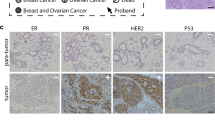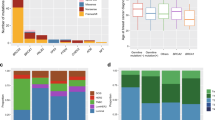Abstract
Hereditary breast and ovarian cancer syndromes can be caused by loss-of-function germline mutations in one of two tumour-suppressor genes, BRCA1 and BRCA2 (ref. 1). Each gene product interacts with recombination/DNA repair proteins in pathways that participate in preserving intact chromosome structure. However, it is unclear to what extent such functions specifically suppress breast and ovarian cancer. Here we analyse what is known of BRCA gene function and highlight some unanswered questions in the field.
This is a preview of subscription content, access via your institution
Access options
Subscribe to this journal
Receive 51 print issues and online access
$199.00 per year
only $3.90 per issue
Buy this article
- Purchase on Springer Link
- Instant access to full article PDF
Prices may be subject to local taxes which are calculated during checkout



Similar content being viewed by others
References
Welcsh, P. L., Owens, K. N. & King, M. C. Insights into the functions of BRCA1 and BRCA2. Trends Genet. 16, 69–74 (2000).
Scully, R. et al. Association of BRCA1 with Rad51 in mitotic and meiotic cells. Cell 88, 265–275 (1997).
Sharan, S. K. et al. Embryonic lethality and radiation hypersensitivity mediated by Rad51 in mice lacking Brca2. Nature 386, 804–810 (1997).
Chen, J. et al. Stable interaction between the products of the BRCA1 and BRCA2 tumoursuppressor genes in mitotic and meiotic cells. Mol. Cell 2, 317–328 (1998).
Scully, R. et al. Dynamic changes of BRCA1 subnuclear location and phosphorylation state are initiated by DNA damage. Cell 90, 425–435 (1997).
Wu, L. C. et al. Identification of a RING protein that can interact in vivo with the BRCA1 gene product. Nature Genet. 14, 430–440 (1996).
Keegan, K. S. et al. The Atr and Atm protein kinases associate with different sites along meiotically pairing chromosomes. Genes Dev. 10 , 2423–2437 (1996).
Cortez, D., Wang, Y., Qin, J. & Elledge, S. J. Requirement of ATM-dependent phosphorylation of brca1 in the DNA damage response to double-strand breaks. Science 286, 1162– 1166 (1999).
Deng, C. X. & Scott, F. Role of the tumor suppressor gene Brca1 in genetic stability and mammary gland tumor formation. Oncogene 19, 1059–1064 ( 2000).
Hakem, R. et al. The tumor suppressor gene Brca1 is required for embryonic cellular proliferation in the mouse. Cell 85, 1009 –1023 (1996).
Patel, K. J. et al. Involvement of Brca2 in DNA repair. Mol. Cell 1, 347–357 (1998).
Sonoda, E. et al. Rad51-deficient vertebrate cells accumulate chromosomal breaks prior to cell death. EMBO J. 17, 598– 608 (1998).
Scully, R. et al. Genetic analysis of BRCA1 function in a defined tumor cell line. Mol. Cell 4, 1093– 1099 (1999).
Moynahan, M. E., Chiu, J. W., Koller, B. H. & Jasin, M. Brca1 controls homology-directed DNA repair. Mol. Cell 4, 511–518 (1999).
Snouwaert, J. N. et al. BRCA1 deficient embryonic stem cells display a decreased homologous recombination frequency and an increased frequency of non-homologous recombination that is corrected by expression of a brca1 transgene. Oncogene 18, 7900–7907 ( 1999).
Scully, R., Puget, N. & Vlasakova, K. DNA polymerase stalling, sister chromatid recombination and the BRCA genes. Oncogene (in the press).
Fornace, A. J. Jr Recombination of parent and daughter strand DNA after UV-irradiation in mammalian cells. Nature 304, 552–554 (1983).
Kowalczykowski, S. C. Initiation of genetic recombination and recombination-dependent replication. Trends Biochem. Sci. 25, 156– 165 (2000).
Cordeiro-Stone, M., Makhov, A. M., Zaritskaya, L. S. & Griffith, J. D. Analysis of DNA replication forks encountering a pyrimidine dimer in the template to the leading strand. J. Mol. Biol. 289, 1207–1218 (1999).
Brown, E. J. & Baltimore, D. ATR disruption leads to chromosomal fragmentation and early embryonic lethality. Genes Dev. 14, 397–402 (2000).
Rotman, G. & Shiloh, Y. ATM: a mediator of multiple responses to genotoxic stress. Oncogene 18, 6135– 6144 (1999).
Lee, J. S., Collins, K. M., Brown, A. L., Lee, C. H. & Chung, J. H. hCds1-mediated phosphorylation of BRCA1 regulates the DNA damage response. Nature 404, 201–204 (2000).
Gowen, L. C., Avrutskaya, A. V., Latour, A. M., Koller, B. H. & Leadon, S. A. BRCA1 required for transcription-coupled repair of oxidative DNA damage. Science 281, 1009–1012 (1998).
Wang, Y. et al. BASC, a super complex of BRCA1-associated proteins involved in the recognition and repair of aberrant DNA structures. Genes Dev. 14, 927–939 ( 2000).
Chapman, M. S. & Verma, I. M. Transcriptional activation by BRCA1. Nature 382, 678– 679 (1996).
Monteiro, A. N., August, A. & Hanafusa, H. Evidence for a transcriptional activation function of BRCA1 C-terminal region. Proc. Natl Acad. Sci. USA 93, 13595–13599 (1996).
Milner, J., Ponder, B., Hughes-Davies, L., Seltmann, M. & Kouzarides, T. Transcriptional activation functions in BRCA2. Nature 386, 772– 773 (1997).
Irminger-Finger, I., Siegel, B. D. & Leung, W. C. The functions of breast cancer susceptibility gene 1 (BRCA1) product and its associated proteins. Biol. Chem. 380, 117–128 (1999).
Bochar, D. A. et al. BRCA1 is associated with a human SWI/SNF-related complex: linking chromatin remodeling to breast cancer. Cell 102, 257–265 (2000).
Guarente, L. Diverse and dynamic functions of the Sir silencing complex. Nature Genet. 23, 281–285 ( 1999).
Paul, T. P. et al. A critical role for histone H2AX in recruitment of repair factors to nuclear foci after DNA damage. Curr. Biol. 10, 886–895 (2000).
Lorick, K. L. et al. RING fingers mediate ubiquitin-conjugating enzyme (E2)-dependent ubiquitination. Proc. Natl Acad. Sci. USA 96, 11364–11369 (1999).
Kordon, E. C. & Smith, G. H. An entire functional mammary gland may comprise the progeny from a single cell. Development 125, 1921–1930 (1998).
Tokunaga, M. et al. Malignant breast tumors among atomic bomb survivors, Hiroshima and Nagasaki, 1950–74. J. Natl Cancer Inst. 62 , 1347–1359 (1979).
Wolden, S. L., Lamborn, K. R., Cleary, S. F., Tate, D. J. & Donaldson, S. S. Second cancers following pediatric Hodgkin's disease. J. Clin. Oncol. 16, 536 –544 (1998).
Kinzler, K. W. & Vogelstein, B. Cancer-susceptibility genes. Gatekeepers and caretakers. Nature 386, 761–763 (1997).
Fishman, J., Osborne, M. P. & Telang, N. T. The role of estrogen in mammary carcinogenesis. Ann. NY Acad. Sci. 768, 91–100 (1995).
Henikoff, S. Nuclear organization and gene expression: homologous pairing and long-range interactions. Curr. Opin. Cell Biol. 9, 388–395 (1997).
Ashe, H. L., Monks, J., Wijgerde, M., Fraser, P. & Proudfoot, N. J. Intergenic transcription and transinduction of the human beta-globin locus. Genes Dev. 11, 2494–2509 (1997).
Miki, Y. et al. A strong candidate for the breast and ovarian cancer susceptibility gene BRCA1. Science 266, 66– 71 (1994).
Tibbetts, R. S. et al. Functional interactions between BRCA1 and the checkpoint kinase ATR during genotoxic stress. Genes Dev. (in the press).
Le Page, F. et al. BRCA1 and BRCA2 are necessary for the transcription-coupled repair of the oxidative 8-oxoguanine lesion in human cells.. Cancer Res. 60, 5548–5552 ( 2000).
Acknowledgements
We thank many colleagues for stimulating discussions and for sharing data before publication. In particular, J. Feunteun, R. Tibbetts, R. Abraham, W. Bonner, M. Gellert and P. Adams.
Author information
Authors and Affiliations
Corresponding author
Rights and permissions
About this article
Cite this article
Scully, R., Livingston, D. In search of the tumour-suppressor functions of BRCA1 and BRCA2. Nature 408, 429–432 (2000). https://doi.org/10.1038/35044000
Issue Date:
DOI: https://doi.org/10.1038/35044000
This article is cited by
-
Prevalence of BRCA1, BRCA2, and PALB2 genomic alterations among 924 Taiwanese breast cancer assays with tumor-only targeted sequencing: extended data analysis from the VGH-TAYLOR study
Breast Cancer Research (2023)
-
The oncogenic fusion protein TAZ::CAMTA1 promotes genomic instability and senescence through hypertranscription
Communications Biology (2023)
-
A BRCA2 germline mutation and high expression of immune checkpoints in a TNBC patient
Cell Death Discovery (2023)
-
In Silico design and characterization of RAD51 protein inhibitors targeting homologous recombination repair for cancer therapy
Genome Instability & Disease (2023)
-
AGuIX nanoparticles enhance ionizing radiation-induced ferroptosis on tumor cells by targeting the NRF2-GPX4 signaling pathway
Journal of Nanobiotechnology (2022)
Comments
By submitting a comment you agree to abide by our Terms and Community Guidelines. If you find something abusive or that does not comply with our terms or guidelines please flag it as inappropriate.



